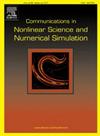椭球面上神经场方程的点解
IF 3.8
2区 数学
Q1 MATHEMATICS, APPLIED
Communications in Nonlinear Science and Numerical Simulation
Pub Date : 2025-07-28
DOI:10.1016/j.cnsns.2025.109172
引用次数: 0
摘要
了解神经领域中激发模式的动态是神经科学的一个重要课题。神经场方程是描述相互作用神经元的激励动力学并进行理论分析的数学模型。尽管许多神经场方程的分析都集中在平面上神经元相互作用的影响上,但在对大脑等器官进行建模时,动力学的几何约束也是一个有吸引力的话题。本文报道了以椭球为模型曲面的神经场方程的模式动力学。我们将点解视为局部图形,并讨论了曲面的几何性质如何改变它们的性质。为了分析小扁平化球面上的斑点图案,首先在球面上构造了精确的静止斑点解,并揭示了它们的稳定性。然后我们扩展了分析,证明了在球面情况下静止点解的存在性和稳定性。我们的理论结果之一是推导了定域于扁圆球上极点的静止点解的稳定性判据。该准则决定了一个点的解是停留在极点还是移开。最后,我们进行了数值模拟来讨论点解的动力学与我们的理论预测的洞察力。我们的结果表明,点解的动力学依赖于曲面和神经相互作用的协调。本文章由计算机程序翻译,如有差异,请以英文原文为准。
Spot solutions to a neural field equation on oblate spheroids
Understanding the dynamics of excitation patterns in neural fields is an important topic in neuroscience. Neural field equations are mathematical models that describe the excitation dynamics of interacting neurons to perform the theoretical analysis. Although many analyses of neural field equations focus on the effect of neuronal interactions on the flat surface, the geometric constraint of the dynamics is also an attractive topic when modeling organs such as the brain. This paper reports pattern dynamics in a neural field equation defined on spheroids as model curved surfaces. We treat spot solutions as localized patterns and discuss how the geometric properties of the curved surface change their properties. To analyze spot patterns on spheroids with small flattening, we first construct exact stationary spot solutions on the spherical surface and reveal their stability. We then extend the analysis to show the existence and stability of stationary spot solutions in the spheroidal case. One of our theoretical results is the derivation of a stability criterion for stationary spot solutions localized at poles on oblate spheroids. The criterion determines whether a spot solution remains at a pole or moves away. Finally, we conduct numerical simulations to discuss the dynamics of spot solutions with the insight of our theoretical predictions. Our results show that the dynamics of spot solutions depend on the curved surface and the coordination of neural interactions.
求助全文
通过发布文献求助,成功后即可免费获取论文全文。
去求助
来源期刊

Communications in Nonlinear Science and Numerical Simulation
MATHEMATICS, APPLIED-MATHEMATICS, INTERDISCIPLINARY APPLICATIONS
CiteScore
6.80
自引率
7.70%
发文量
378
审稿时长
78 days
期刊介绍:
The journal publishes original research findings on experimental observation, mathematical modeling, theoretical analysis and numerical simulation, for more accurate description, better prediction or novel application, of nonlinear phenomena in science and engineering. It offers a venue for researchers to make rapid exchange of ideas and techniques in nonlinear science and complexity.
The submission of manuscripts with cross-disciplinary approaches in nonlinear science and complexity is particularly encouraged.
Topics of interest:
Nonlinear differential or delay equations, Lie group analysis and asymptotic methods, Discontinuous systems, Fractals, Fractional calculus and dynamics, Nonlinear effects in quantum mechanics, Nonlinear stochastic processes, Experimental nonlinear science, Time-series and signal analysis, Computational methods and simulations in nonlinear science and engineering, Control of dynamical systems, Synchronization, Lyapunov analysis, High-dimensional chaos and turbulence, Chaos in Hamiltonian systems, Integrable systems and solitons, Collective behavior in many-body systems, Biological physics and networks, Nonlinear mechanical systems, Complex systems and complexity.
No length limitation for contributions is set, but only concisely written manuscripts are published. Brief papers are published on the basis of Rapid Communications. Discussions of previously published papers are welcome.
 求助内容:
求助内容: 应助结果提醒方式:
应助结果提醒方式:


